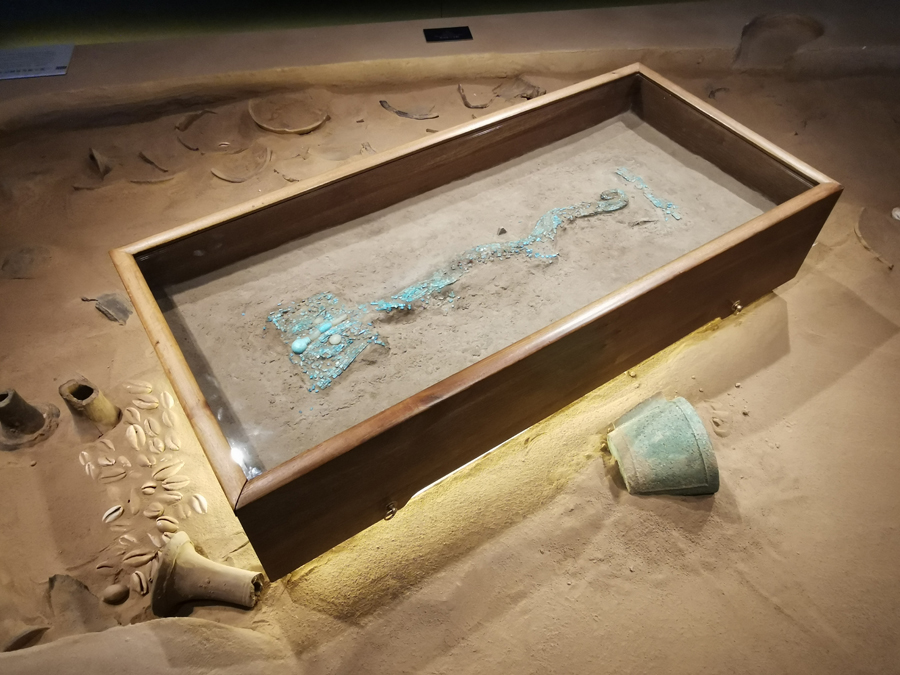
Modern technology and 60 years of historical analysis are shining fresh light on the earliest central dynasty of China, Wang Kaihao reports in Luoyang, Henan province.
Just as the ancient city of Troy is to Western civilization, the Xia Dynasty (c. 21st century-16th century BC), the first central dynasty in recorded Chinese history, is the stuff of legend in China.
Generations of archaeologists have attempted to prove its existence as more than a mere myth through a succession of excavations across the Central China Plain-a region generally regarded as the cradle of Chinese civilization.
But thanks to carbon dating at the ruins of the ancient capital that existed from 1750 to 1520 BC discovered at Erlitou in Luoyang, Henan province, fresh light is being cast on many of the puzzles archaeologists have struggled to solve over the years.
On Oct 20, the 164,000-square-meter Erlitou Relic Museum of the Xia Capital, which took 600 million yuan ($85 million) and 30 months to construct, opened to the public alongside a 700,000-square-meter archaeological ruins park.
They were welcomed by a large crowd of curious visitors eager to catch a glimpse of “earliest China”, a term coined by Xu Hong, a researcher with the Institute of Archaeology of the Chinese Academy of Social Sciences, in his books.
As the head of archaeological projects on the site since 1999, Xu has taken on the role of host at Erlitou. He also organized an international academic symposium at the museum to mark its opening. However, Xu’s views don’t necessarily follow the norms of academia, and he still does not fully agree with the name chosen for the new museum.
“Erlitou marks the earliest central kingdom in a vast territory within East Asia,” Xu says. “But we have to retain a scientific approach. It’s still premature to link the findings of the past 60 years, however significant, to a certain dynasty appearing in ancient historical documents.”

The city ruins cover an area of 3 sq km, and according to Xu, the Erlitou site contains the oldest quadrangle palatial complex ever discovered in China.
“It’s the earliest prototype of the Forbidden City in the country,” he explains.
Other than that, China’s earliest known handicraft workshop and remains of a bronzeware production site and turquoise-processing facilities, an urban road network featuring paths as wide as 20 meters, and ruts made by double wagon wheels over the centuries, were all found at the Erlitou site.
In 2002, Xu unearthed a dragon-shaped decorative object made up of over 2,000 pieces of turquoise in a tomb together with several bronze bells. This crucial finding is widely interpreted by archaeologists as a symbol of kingship due to the presence of the dragon totem.
Turquoise-inlaid bronze plates bearing animal mask patterns were other important pieces unearthed during these excavations. And the abundance of ceremonial bronze and jade artifacts and exquisite works of pottery all marked this site out as an exceptional one.
Nevertheless, Xu says while no written evidence found on the objects at Erlitou directly prove its connection with the Xia Dynasty, the final pieces of the puzzle in identifying the dynasty have still yet to be found.
Only simple inscriptions carved into pottery have been found at the Erlitou site to date.
“Nevertheless, this lack of clarity is not an obstacle for us to understand the unparalleled significance of this site in early Chinese civilization,” Xu adds.

Decoding history
During the 1920s, the 3,000-year-old Yinxu Ruins were discovered in Anyang, Henan province. An abundance of oracle bones-the earliest form of Chinese writing carved onto animal bones to be used as records-were unearthed, which helped to recast the Shang Dynasty (c. 16th century-11th century BC) from a mythical entity into an indisputable part of Chinese history. Yinxu is now proved to be the location of the last capital city of the Shang era.
So, what about the earlier Xia Dynasty?
According to the Bamboo Annals, a collection of chronicles from the Warring States period (475-221 BC), the dynasty existed for 471 years before the Shang era and spanned the reigns of 14 kings over 11 generations.
In 1959, scholar Xu Xusheng led a research team on a field trip to Henan, following clues from key works of ancient historiography, including Shi Ji, or Records of the Grand Historian, from the Western Han Dynasty (206 BC-AD 24).
Xu Xusheng discovered the vast site at Erlitou village, but later concluded that his findings marked out the capital of the early Shang Dynasty-historically known as Xibo-by analyzing the patterns of the cultural relics unearthed there.
His supposition remained the dominant theory in Chinese academia until the early 1980s, when a “younger” set of city ruins covering an area of some 2 sq km were found just 6 km away from Erlitou. As it appeared to date back to the early Shang Dynasty, another theory rose to become the mainstream hypothesis: namely that the Erlitou site was in fact Zhenxun, the last capital of the Xia Dynasty as recorded in the Bamboo Annals.
From 1996 to 2000, a national-level program for the specific periodization of the Xia and Shang dynasties was organized, involving a host of top Chinese archaeologists, paleographers, historians and astronomers.

According to the conclusion of that program, and based on a rigorous analysis of historical records, archaeological findings and astronomical records, the Shang people were found to have toppled the Xia Dynasty in around 1600 BC.
Li Boqian, a professor of archaeology at Peking University, was the chief scientist of the program. He cites their work as key to defining the Xia Dynasty as a proven historical fact.
“The richness of the historical records about ancient China were an advantage for us archaeologists, rather than a burden,” Li says. “Erlitou was a key witness to the transition from the Xia Dynasty to the Shang era.
“During later archaeological analysis of the Erlitou site, we found a lot of evidence indicating social upheaval-such as former palaces being abandoned-at a time when Shang culture began to surface,” he explains.
“However, the Shang Dynasty allowed Xia loyalists to remain in the area, and that’s why their residence continued for a longer period of time.”
While it remains controversial as to whether the Shang city near Erlitou is Xibo, their affinity at least shows that the Shang people wanted to keep a close eye on those loyal to the former dynasty in case of a rebellion, Li adds.
“The Shang city could also be a military fort used for surveillance,” he says.
Chen Xingcan, director of the Institute of Archaeology of CASS, says naming the new museum Xia Capital represents a mainstream view and will help the general public to understand the importance of the site, but it does not mean the end of the discussion.

“It is highly possible that the Erlitou site was the capital of the Xia Dynasty, according to the research, but there is still a big gap between being 99 percent and 100 percent sure,” he says. “The question is still open-ended.”
Whether they support the Xia capital status of Erlitou or not, experts from both sides have reached consensus on one point: It is a national hub of early Chinese civilization.
According to Wang Wei, director of the Society of Chinese Archaeology, early-stage civilizations appeared in China about 5,000 years ago along the Yellow, Yangtze and Liaohe rivers, and some of them entered the stage of “early state”. The Erlitou site shows the assimilation of elements from different cultures and the rise of the Central China Plain as a “core”.
“The ritualistic system of Erlitou Culture radiated to many far-away regions, which also shows a vast influence,” Wang says. “That was how our country began to form.”
For example, all over today’s China, as far as Guangdong province and Hong Kong to the south and Gansu province to the west, archaeologists have unearthed yazhang, a typical jade ritual artifact indicating state power in Erlitou Culture.
“Many local cultures accepted the influence of the central kingdom,” Xu Hong says. “The expansion of Erlitou Culture did not rely on military power or violent conquest-it used the soft power of a highly developed society.
“Focusing on studies of human settlements, we now have a comprehensive understanding of ancient society then, which has gone beyond the dispute over which dynasty it belonged to,” he adds.

New perspectives
The introduction of an approach based on the natural sciences has thrown new light on what China was like in its infancy.
For instance, Yuan Jing, a professor at Fudan University in Shanghai, says rice produced in the south of China makes up more than 30 percent of the grains excavated from the Erlitou site.
“We need more samples to see whether the unconventionally high percentage of rice indicates a tribute system,” he says.
Through gene studies on human remains found in Erlitou, it is also possible to check the origins of their migration.
“It will provide many interesting findings in a few years if we have comparative studies of their genes with those from subjects found in Yinxu,” Yuan says.
“The six decades of study in Erlitou shows the developing ideas and research methods of Chinese archaeology,” Chen observes. “Interdisciplinary cooperation helps us to answer more questions.”
Xu Hong says he believes Erlitou should be added to a global picture in order to see its pivotal role in the Bronze Age.
“The first globalization began 4,000 years ago,” he says. “Different civilizations began to communicate with each other on the vast Eurasian grassland, spreading production techniques.”
He says the world’s earliestknown metallurgy of bronze appeared in West Asia, but Erlitou marks a monumental waypoint in the development of bronzeware.

“The shapes, patterns and production skills all went in a new direction, and local bronzeware in China saw a boom in production,” he explains. “It contributed to the spread of bronzeware in East Asia, which was like a wave.”
The researcher has also cooperated with Tang Chung, a professor at the Chinese University of Hong Kong, to understand the global significance of Erlitou turquoise through comparative studies.
“China was one of the earliest regions in the world to use turquoise,” Tang says. “It appeared about 8,000 years ago in Jiahu (an archaeological site in Luohe, Henan), and China’s technology for processing it probably led the world for a long time.
“However, importance of Chinese turquoise was barely noticed, because the tradition faded away after it reached its peak during the Bronze Age,” he notes.
“More studies on the production system of our turquoise in Erlitou can also better reveal the social structures of the era.”
As for the solution to the Xia puzzle, new clues continue to be found that cast new light on the conundrum.
Li Weiming, a researcher at the National Museum of China, while studying an ox bone that was unearthed in 1991 in Mixian county, Henan, stumbled across two carved symbols that looked like Chinese characters. After further examination of the bone-which dates back to the Erlitou Culture period-and analyzing the evolution of various characters, he identified one of them as xia.
“A single example may hardly count,” Xu Hong says. “But if, in the future, similar characters are found at the Erlitou site that potentially change history, I will not be surprised.”



